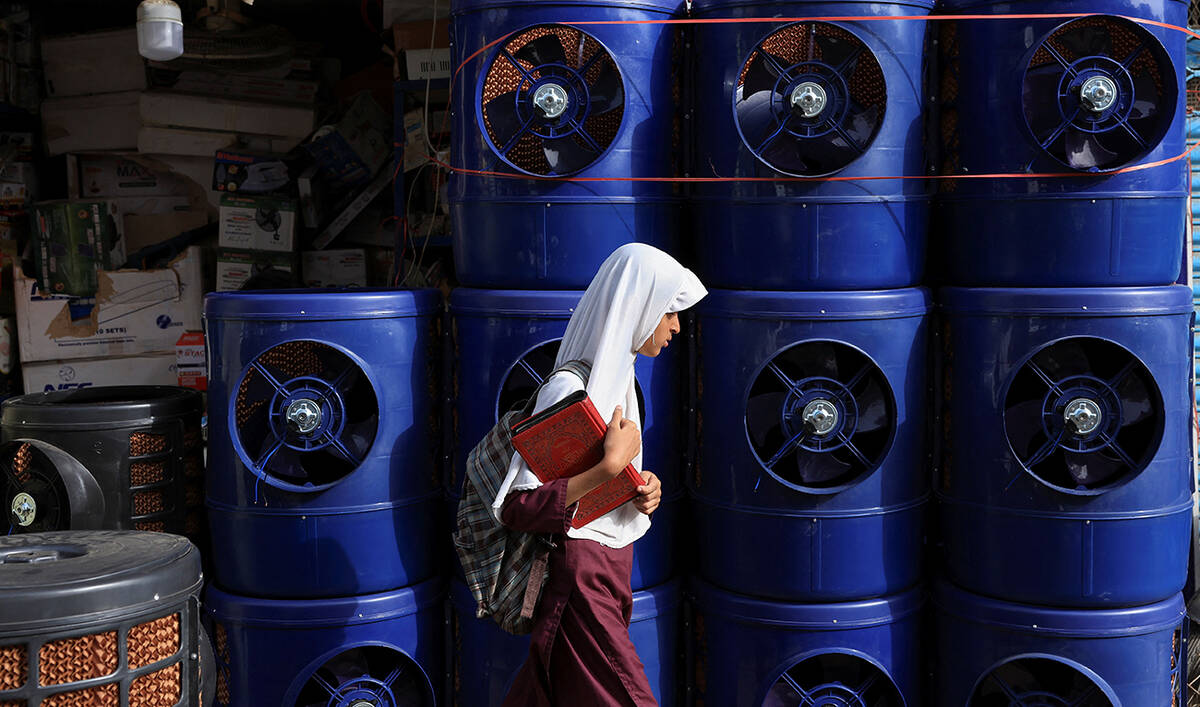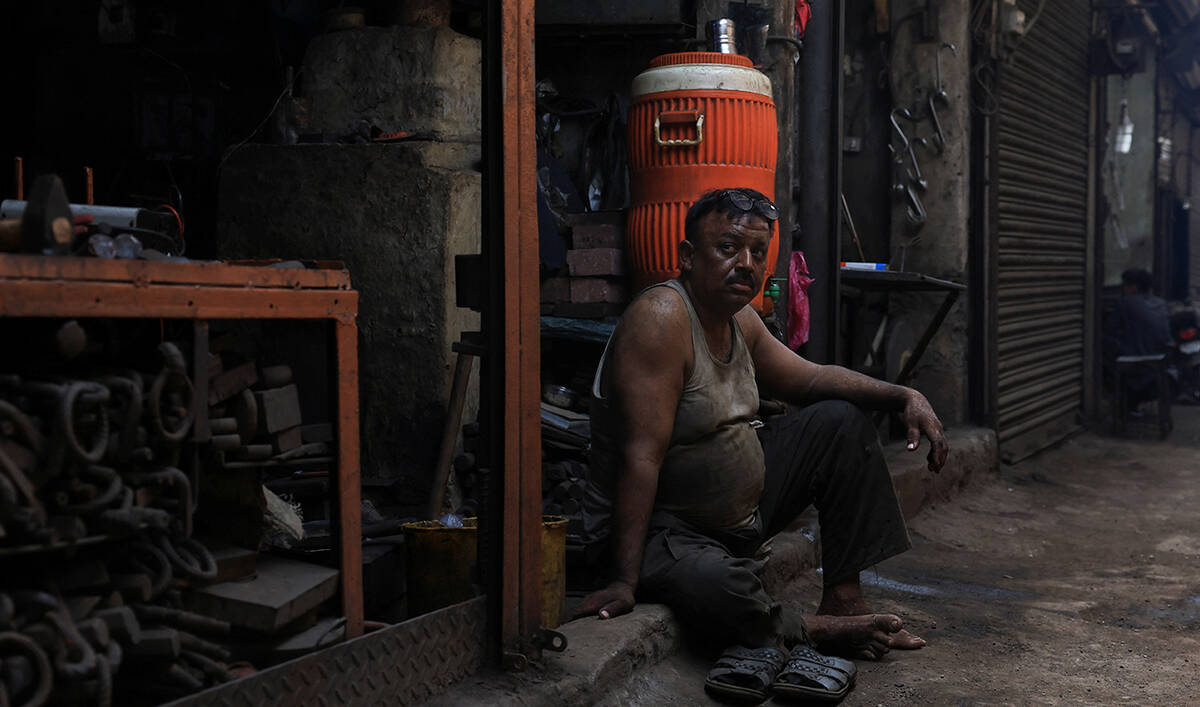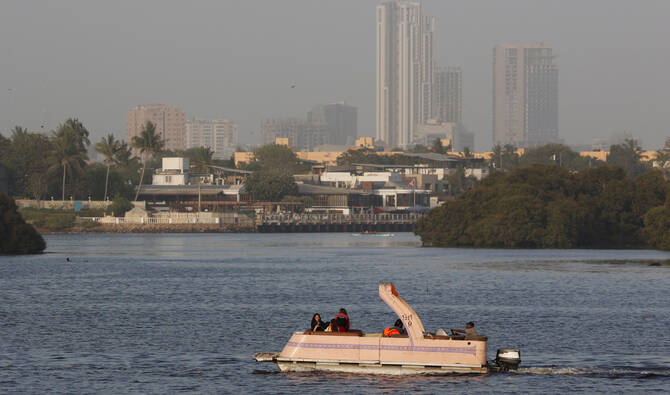ISLAMABAD: A group of militants targeted a Pakistani border post in the country’s southwestern Balochistan province from the Iranian territory, said the Pakistan Army’s media wing on Tuesday, adding that the country had informed the relevant Iranian authorities about the incident.
Last week, Pakistan’s counterterrorism police announced that a suicide bomber who tried to target a caravan of Chinese nationals in August had also arrived in the Pakistani port city of Gwadar from Iran.
The revelation came after the arrest of three members of the Balochistan Liberation Army, a proscribed separatist outfit, which had claimed the responsibility for the attack.
During the course of the interrogation, one of the suspects informed that the mastermind of the Gwadar attack was a resident of Chahbahar in neighboring Iran.
“Terrorists targeted a Frontier Corps border post from Iranian territory with Small Arms fire in general area Chukab, Balochistan,” the military said in its statement. “Due to fire, Sepoy Maqbool Shah of Frontier Corps embraced shahadat [martyrdom] while another soldier was injured. Iranian authorities concerned have been informed about the incident.”
Pakistan has frequently complained about militant attacks from Iran and Afghanistan in the past, making its officials fence its porous border with its two western neighbors.
The country’s top military officials have also maintained they have fenced a large portion of its western frontier, though the challenge of cross-border movement and such militant attacks continue.
Pakistan’s border post in Balochistan targeted by militants from Iranian territory — army
https://arab.news/4y3c9
Pakistan’s border post in Balochistan targeted by militants from Iranian territory — army

- The country’s counterterrorism police recently said last month’s Gwadar attack on Chinese nationals was also planned in Iran
- Pakistan has been trying to fence its western border with Iran and Afghanistan to address cross-border movement, militant threats
Death toll from Pakistan building collapse rises to 23

- Friday’s incident was the latest in a string of deadly building collapses in Karachi
- It laid bare the issue of unsafe housing in the city, home to over 20 million people
KARACHI: The death toll from a five-story building collapse in the southern Pakistani city of Karachi rose to 23 late Saturday, the Sindh Health Department said after rescuers pulled more bodies from the rubble.
The Fotan Mansion residential building, where several families were said to be living, crumbled around 10 am on Friday in the impoverished Lyari neighborhood of the city.
Rescue workers, along with residents of the area, worked through the night to find survivors and bodies after the incident, which has once again laid bare the issue of unsafe housing in Karachi.
“[Total deaths] from the Karachi building collapse have reached 23 now,” the Sindh Health Department said in a message sent to reporters.
Karachi Mayor Murtaza Wahab said on Saturday morning the rescue operation was still ongoing at the collapse site.
“Rescue operation still continues at Baghdadi Lyari where the building had collapsed yesterday,” Wahab wrote on social media platform X.
Many of the occupants were members of the low-income Hindu minority community and residents estimated that around 40 people were inside when the building collapsed.
According to the Sindh Building Control Authority (SBCA), Fotan Mansion had been declared unsafe three years ago.
“This building was declared dangerous by the SBCA in 2022 and had been served multiple notices over the years,” SBCA spokesperson Shakeel Dogar told Arab News on Saturday.
“Before the recent rains, public announcements were also made in the area, but unfortunately, no one was willing to vacate.”
Friday’s incident is the latest in a string of deadly building collapses in Karachi.
In February 2020, a five-story building collapsed in Rizvia Society, killing at least 27 people. The following month, another residential structure came down in Gulbahar, claiming 16 lives. In June 2021, a three-story building in Malir collapsed, killing four. And just last year, in August, a building collapse in Qur’angi led to at least three deaths.
Mayor Wahab said on Friday evening that rescue efforts remained the city government’s top priority, with accountability and investigation to follow.
“Once we’re done with the rescue aspect, we will focus on who was responsible for this negligence or omission,” he added.
Minister orders probe into killing of barking deer on Islamabad’s Margalla Hills

- The South Asian country has witnessed frequent incidents of violation of wildlife laws
- This week, an escaped pet lion attacked a woman, two children in a busy street in Lahore
ISLAMABAD: Pakistan’s Minister for Climate Change and Environmental Coordination Dr. Musadik Malik has taken notice of the killing of an endangered barking deer on Islamabad’s Margalla Hills and ordered a probe into the incident, the Press Information Department (PID) said on Saturday.
Barking deer, also known as Indian muntjac, are found in isolated populations within Margalla Hills National Park, Khanpur Range and Lathrar near the Pakistani capital of Islamabad. They are considered endangered in Pakistan due to their restricted range and declining population.
A disturbing video circulating on social media this week showed three men slaughtering the rare animal on the roadside and has sparked public anger and calls to investigate the incident.
Climate Change and Environmental Coordination Minister Malik condemned the hunting and killing of wildlife in protected areas, according to a PID statement.
“Such acts of cruelty and disregard for conservation laws are unacceptable and will not be tolerated,” the minister, who has sought a report from authorities on the incident, was quoted as saying.
Separately, the Islamabad Wildlife Management Board (IWMB) said it had filed a complaint with police, seeking action against the ones involved in the incident for violating the Islamabad Nature Conservation and Wildlife Management Act.
“Barking deer is a protected animal under Schedule 1 of the act,” the IWMB said on X. “A request has been made for action under sections 12.4(a) and 16.1(a) of the Nature Act 2024.”
The board said a violation of the relevant section of the law is punishable by a fine of Rs1 million ($3,523) and imprisonment for a term of up to one year.
Pakistan has witnessed frequent incidents of violation of wildlife laws.
An escaped pet lion chased a woman and two children down a busy street in Pakistan’s Lahore, police said Friday, with dramatic footage showing the big cat leaping a wall before pouncing on them. All three were taken to hospital but were not in a critical condition.
Keeping exotic animals, especially big cats, as pets has long been seen as a sign of privilege and power in Punjab, the most populous province of the country.
Police said they had arrested three men.
“The suspects fled from the spot, taking the lion with them. They were arrested within 12 hours of the incident,” the office of the Deputy Inspector General Operations in Lahore said.
The lion, an 11-month-old male, has been confiscated by police and sent to a wildlife park.
Pakistan, UAE agree to boost cooperation in higher education, human resources

- The UAE is home to over 1.5 million Pakistanis who send more than $5 billion in remittances annually
- Both countries resolve to work on initiatives to benefit students, academic institutions and professionals
ISLAMABAD: Pakistan and the United Arab Emirates (UAE) have agreed to strengthen bilateral cooperation in higher education and human resource development, the Pakistani embassy said on Saturday.
The statement came after a meeting between Pakistan’s Ambassador Faisal Niaz Tirmizi and Dr. Abdulrahman bin Abdulmanan Al-Awar, the UAE minister of human resources, higher education and scientific research.
The UAE is home to more than 1.5 million Pakistani expatriates who live and work in the Gulf country and send back more than $5 billion in remittances to the South Asian country annually.
During the meeting, Ambassador Tirmizi highlighted the contributions of the Pakistani community to the UAE’s development and appreciated the Gulf country for fostering an inclusive and enabling environment for expatriates.
“Both sides reviewed ongoing collaboration and explored avenues to further enhance bilateral cooperation in the fields of higher education and human resource development,” the Pakistani embassy said.
“The discussions reflected a shared resolve to work closely on initiatives that benefit students, academic institutions, and professionals from both countries.”
Ambassador Tirmizi reiterated Pakistan’s commitment to strengthening institutional linkages and advancing cooperation in skill development and workforce preparedness.
“Minister Dr. Abdulrahman Al-Awar lauded the longstanding and brotherly relations between the two countries and expressed the UAE’s keen interest in expanding its partnership with Pakistan in mutually beneficial areas,” the Pakistani embassy said.
“He welcomed sustained dialogue and coordination between the relevant authorities of both nations.”
Eight militants killed in separate operations in Pakistan’s Punjab, Khyber Pakhtunkhwa

- The operations were conducted in Lakki Marwat and near Taunsa Sharif on the reported presence of militants
- Pakistan has witnessed a sharp rise in militancy in its western regions bordering Afghanistan in recent months
KARACHI: At least eight militants were killed in two separate operations in Pakistan’s Punjab and Khyber Pakhtunkhwa (KP) provinces, authorities said on Saturday.
In the first incident, officials of the KP counter-terrorism department (CTD) and police conducted a raid in the Lakki Marwat district which resulted in an encounter with militants.
The shootout left three members of the Pakistani Taliban’s Tipu Gul group dead, whereas officials seized three Kalashnikovs and hundreds of rounds from the site, according to a CTD statement.
“These militants were actively engaged in targeted killings and direct assaults against law enforcement personnel, including multiple CTD and district police officials,” the statement read.
In another operation in Punjab, CTD and police personnel gunned down five Pakistani Taliban militants near Taunsa Sharif district, the interior ministry, adding referring to them as “Indian-sponsored terrorists.”
“Punjab police and the CTD thwarted the nefarious motives of Khawarij [Pakistani Taliban] terrorists,” Interior Minister Mohsin Naqvi was quoted as saying. “We will continue to chase the terrorists of Fitna Al-Hindustan everywhere.”
Pakistan has witnessed a sharp rise in violence in its western regions bordering Afghanistan.
On Friday, the Pakistani military said security forces had killed at least 30 “Indian-sponsored” militants while attempting to cross into Pakistan through its border with Afghanistan this week.
Islamabad accuses India of backing militant groups and Afghanistan of allowing the use of its soil for attacks against Pakistan. Kabul and New Delhi deny the allegation.
As Karachi heats up, class and access divide city into a ‘climate apartheid’

- Pakistan’s largest city exposes a stark class divide in access to electricity and cooling as temperatures soar
- In some neighborhoods, electricity lasts two hours a day while the wealthy stay cool with air-conditioning, solar backup
KARACHI: When the sun rises over the portside slums of Keamari in the Pakistani megacity of Karachi, 48-year-old mason Fazal Rahim steps out with his rusted tools into the searing heat.
By the time he returns home at night, drenched in sweat, there’s often no electricity to power even a single fan.
“It’s still unbearably hot and there’s no electricity either,” Rahim told Arab News.
“Our home turns into a hell, the children cry and heat rashes break out on their skin.”
As Pakistan’s largest city sweltered through a record-breaking heatwave in June, temperatures soared past 42 degrees Celsius (over 107°F), exposing a harsh urban reality: while the wealthy kept cool in air-conditioned homes, the poor suffered hours of unrelenting heat in overcrowded neighborhoods plunged into darkness by extended power outages.
Karachi’s two-tiered climate reality, shaped by class and access, now resembles what human rights advocates describe as “climate apartheid,” a term that captures how climate change disproportionately affects marginalized populations while the wealthy remain buffered.
Hospitals across the city, including the government-run Jinnah Postgraduate Medical Center (JPMC), saw a spike in heat-related illnesses.
“We had nearly a thousand patients last year who came in with heatstroke,” said Dr. Irfan Siddiqui, head of JPMC’s emergency department, citing a rise in cases of dehydration, food poisoning and heat exhaustion this year.
POWER DIVIDE
More than 90 percent of Pakistan’s international trade flows through Karachi, a city of over 20 million people and the country’s economic engine. But despite its centrality to Pakistan’s economy, the city’s basic infrastructure, especially in its low-income neighborhoods, is chronically neglected.

Some residents, like Rahim in Bhutta Village, reported only two hours of electricity in a full day last month. In stark contrast, affluent areas such as Clifton and Defense Housing Authority (DHA) remained largely unaffected by power outages, with many homes powered by private solar panels or diesel generators.
K-Electric, the city’s sole power distributor, insists the disparity is not based on class.
“The load-shedding schedule is purely determined on a commercial basis,” said Bilal Memon, a spokesperson for the utility. “Areas with higher theft and lower bill recovery face longer outages.”
Pakistan’s National Electric Power Regulatory Authority (NEPRA) confirmed in its latest State of Industry Report (2023) that Karachi faces some of the highest transmission and distribution losses among major cities — a result of illegal connections, aging infrastructure, and weak governance. The report also noted that high-loss areas tend to face longer outages as a penalty mechanism.
For those already on the margins, like Tahira Perveen, a widowed asthma patient residing in the low-income Manzoor colony, the unpredictability of the electricity supply can be dangerous.
“As for electricity, no one knows when it will come,” she said. “During the heat, it [the outage] happens all night and all day.”
A CITY GETTING HOTTER
Karachi is among the world’s ten fastest-warming megacities, according to urban climate assessments by the United Nations Environment Program. The city has warmed at nearly double Pakistan’s national average, with temperatures rising by approximately 0.34°C per decade since 1960, according to Sardar Sarfaraz, the former director of the Pakistan Meteorological Department.
The causes are well documented: unchecked urbanization, the destruction of green spaces, and widespread use of concrete that traps heat. Karachi lost over 20 percent of its tree cover between 2008 and 2019, according to satellite data analyzed by the Global Forest Watch platform.

“There are narrow lanes, very, very poorly ventilated houses, and it’s all a concrete jungle,” said Karachi-based climate expert Afia Salam.
“There is a segment, large segment of population, which is more impacted than the others. And then on top of it, if I put the gender lens on, the women are more impacted because culturally, they do not have access to the open spaces.”
Indeed, in the city’s informal settlements, women and children are often confined indoors, where poor ventilation and a lack of cooling options increase health risks during heatwaves.
CLIMATE INEQUALITY
Pakistan is ranked among the top ten countries most vulnerable to climate change, according to the Global Climate Risk Index by Germanwatch. Nearly 45 percent of its population lives below the poverty line, per the World Bank, and the country faces mounting challenges in coping with environmental shocks — from floods and droughts to rising temperatures.
In 2024, the International Monetary Fund approved $1.3 billion in climate-linked funding for Pakistan to support adaptation and resilience efforts. But activists say little climate funding is reaching those most in need.
“The policies being made don’t reflect the ground realities,” said Fatima Majeed, an activist working with coastal communities affected by rising sea levels and heat. “The people for whom these policies are intended are rarely consulted.”

Her concerns were echoed by Yasir Husain, founder of the Karachi-based Climate Action Center.
“We find that the government is least interested in this,” he said. “When there are programs, there is funding. [But] that money is not used to help the vulnerable populations.”
Sindh’s Environment and Climate Change Secretary, Agha Shahnawaz Khan, pointed to ongoing efforts: penalizing smoke-emitting vehicles, tree plantation drives, mangrove restoration and solarizing public buildings.
“We will continue to lag behind until the community supports the government and the government takes proper initiatives,” he said.
COOLING FOR A FEW
Twelve kilometers from Rahim’s baking slum, Dr. Navaira Ali Bangash lives in comfort, her home equipped with air conditioners and backup power systems.
“We are probably the most privileged people who have air-conditioning installed at our homes, offices and even in our cars,” she said. “But then there are those underprivileged people... who cannot even afford basic fans.”

While climate change is often described as a global challenge, in Karachi it is deeply local — a force that exposes long-standing inequalities in housing, infrastructure, and health care.
For Rahim, the national climate discourse and international funding commitments matter little. His immediate concern is whether the ceiling fan in his single-room home will run tonight.
“Electricity [outages] have made our lives miserable,” he said, his voice tired and defeated in the oppressive heat.










